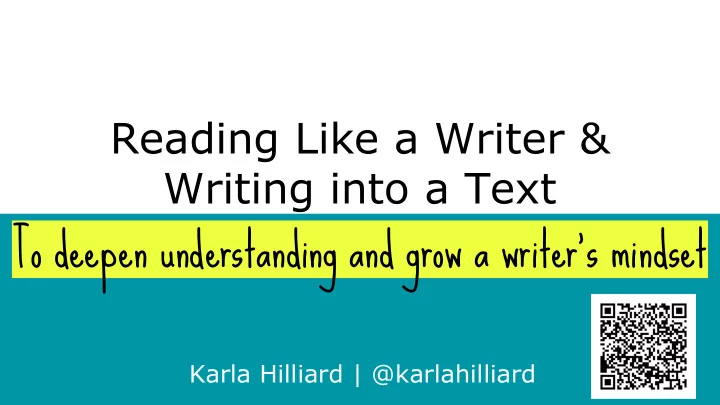

Reading Like a Writer & Writing into a Text To deepen understanding and grow a writer’s mindset Karla Hilliard | @karlahilliard
When you read like a writer and think like a writer, you are a writer.
Reading Like a Reader vs. Reading Like a Writer Readers → unpack meaning Writers → unpack “craft moves” Readers → analyze diction and figurative language Writers → notice choices and ask how it’s made Readers → consider deeper meaning and purpose Writers → consider how it’s achieved Central Question: What do you notice?
Writing Into the Text
What: Why: Using classroom texts Puts students in frame of ● as mini mentor study to mind of writer develop intentional Reiterates intention and ● writers choices of writer Deepens understanding of ● text How: Allows students to try out ● craft moves in their own Teacher or students writing and transfer skills select rich mini-mentors Seamless instruction in ● from in-class texts, and reading, writing, thinking then read, notice, and write
Mini Mentor Text from Beloved by Toni Morrison Purpose: Writing with Intention for Effect During, before and after the War he had seen Negroes so stunned, or hungry, or tired or bereft it was a wonder they recalled or said anything. Who, like him, had hidden in caves and fought owls for food; who, like him, stole from pigs; who, like him, slept in trees in the day and walked by night; who, like him, had buried themselves in slop and jumped in wells to avoid regulators, raiders, paterollers, veterans, hill men, posses and merrymakers. Once he met a Negro about fourteen years old who lived by himself in the woods and said he couldn't remember living anywhere else. He saw a witless coloredwoman jailed and hanged for stealing ducks she believed were her own babies. Move. Walk. Run. Hide. Steal and move on.
What happens? What do you notice about its construction? What could you borrow? An invitation to write... Borrow a move from the writer to describe a person or discuss an experience.
How it translated to student writing
For extended study “what the ___ said to the black boy” poems
Writers of “what the ___ said to the ___ poems”... Include thoughtful stanza breaks ● Might give speaker a dialect ● Give objects life, agency, and voice ● Include shifts to make meaning ● Use repetition for effect ● Use personification ● Use punctuation purposefully ● Use thoughtful and intentional word choice for effect ● Create a deeper meaning ● Combat stereotype ● Speak to the “black boy” as if he is the audience ● Create an ending line that leaves you thinking ●
Student models in handouts!
Student Reflections
Mantra: Read Customizable beautiful stuff; to skill & write beautiful purpose stuff. Students Good practice writers enhanced read good close writing. reading. Opportunities Students for build conference & mentor Teacher Takeaways revision text habits of mind.
Recommend
More recommend